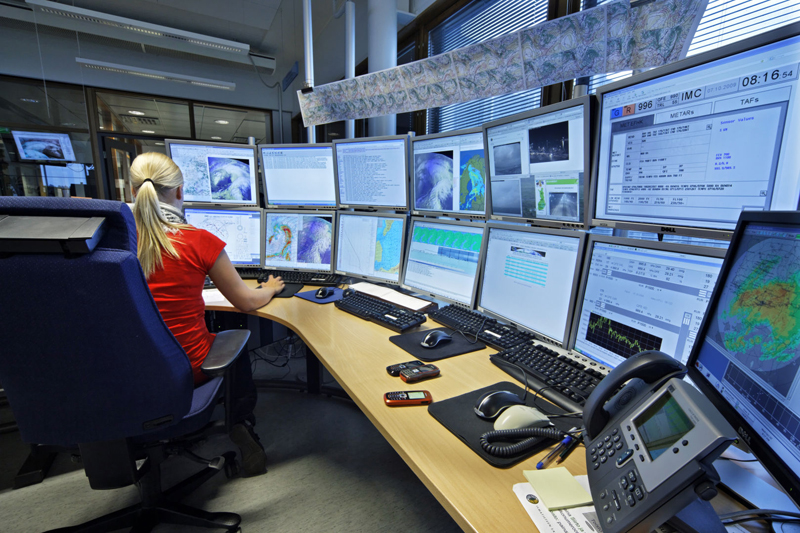WP2: Probabilistic Winter Weather Prediction
Objectives
- Calculate motion vectors of precipitating areas and estimate their uncertainty
- Provide real time forecast of probability distribution of precipitation intensity for WP5
- Optimize forecast by verification in winter conditions.
- Provide measure of predictability for WP5 and WP3
Description of work
The aim of this work package is to develop methods for winter weather forecasting at airports. The key component is motion analysis of precipitating areas. This will be done by using consecutive radar images from either a single radar, national or international radar composite. The motion vectors and their uncertainties give the spread of future movement. Based on this information, a group of trajectories, typically 50, is computed for ensemble forecasts of precipitation. These fast and short-time forecasts are usually called nowcasts. As opposed to nowcasting of summertime convection, growth and decay of precipitation areas are less important in winter conditions, and thus we omit these factors for simplicity.
The nowcast output is a probability distribution of precipitation intensity in native units (dBZ) of radar. The key advantage of the probabilistic approach is that we obtain not only the most likely outcome but also forecast uncertainties. The lead time of a nowcast is typically 15 minutes up to 3 hours, and the run time of one nowcast computation is about one minute to keep the system in real time. The forecasting process is repeated at 15 minutes interval, or more often, depending on radar data update rate. Nowcasts are computed simultaneously to several airports. In this package, we are primarily interested in point forecasts, but the concept can be extended to areal nowcasting.
The reliability of nowcasts will be verified by comparing them to actual radar images. Comparison to ground-based measurements will be considered as an option. This information can be used to enhance the end-user products. Based on this information, one can also determine the lead time after which a nowcast becomes worse than a numerical weather prediction (NWP) model forecast. This potentially supports adaptive blending of radar- and NWP-based forecasts.
Tasks
Task 2.0: Coordination of WP2
The coordination task assures the timely progress of the work and organizes workshops and phone conferences to monitor and optimize the progress among the involved teams. It is responsible for the co-operation with the project management in WP1 in the form of regular progress reporting and preparation of the deliverables according to the agreed schedule.
Task 2.1: Ensure radar data availability
All the partners have access to archived and new collected radar data, where suitable subsets can be selected. In this WP the main source of radar data will be FMI network of 10 C-band radars, archived since 2001. Due to international co-operation in other projects we also have access to data from other countries. The raw measurement data is applied in this project as it is adopts better to handling local orography, quality control and algorithm development. Additional volume data potentially provided by the project partners will be applied as well. All major airports have a good radar coverage, and thus near-range radar measurements are available. Therefore, using ground measurements for additional verification will be given a lower priority.
Task 2.2: Develop algorithms and software to analyze motion vectors
This task focuses on deriving motion fields between consecutive radar images. There are several algorithms available; one of the key issues is to optimize the tradeoff between computation speed and quality of the resulting motion fields. In addition, motion analysis is done in several spatial scales with the ultimate aim of improving the reliability of the forecasts.
Task 2.3: Develop software to compute nowcast of probability distribution of precipitation intensity
The motion vectors and their uncertainties (Task 2.2.) are applied to obtain ensemble forecasts, that is, probability distributions of several alternative forecasts.
Task 2.4: Develop algorithm and software to analyze predictability of nowcasts
Statistical tools for quantifying forecast uncertainties and their broadening with respect to lead time are developed in this task. This information describes the quality of the final forecast products.
Task 2.5: Develop the optimization process to minimize nowcast errors by verification
The objective of this task is to develop statistical tools for calibrating the ensemble probability distributions (from Task 2.3). In this way, we obtain forecasts giving the best match with the actual weather conditions.
Task 2.6: Establish data dissemination procedure for WP5 software
This task involves agreeing on data formats and routines of transferring ensemble forecasts to tools development (WP5).
Task 2.7: Test and optimize performance
In this task, feedback from WP3-WP7 will be adopted to fine-tune the computation.
Task 2.8: Publications
Task 2.8 coordinates the publication of the results from tasks 2.1 to 2.7 in refereed scientific journals, various aviation-related publications and at conferences suitable for the addressed topics. The Task will provide a description document of the WP2 publications accessible at the web.

Photo: Anton Halas.
